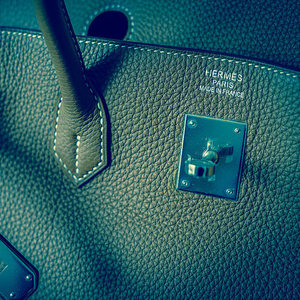The luxury goods company Hermes makes and sells a high-end purse it calls the Birkin Bag. The Birkin costs $10,000—often more—and it is nearly impossible to find one to buy. Because very few bags are available, the Birkin has become a status symbol, something only very few people can buy. Its scarcity raises its value, which could explain why a purse can cost so much money. Listen to find out why a retail company, that by definition wants to sell things, makes it so difficult to buy their product.
Listen to the story
ROBERT SIEGEL: A Birkin costs between $10,000 and $200,000. It’s a bag – a purse made by the French luxury brand Hermes. And here’s the weird part. Birkins are almost always mysteriously out of stock. Stacey Vanek Smith from our Planet Money podcast explains.
STACY VANEK SMITH: Wednesday Martin can remember the exact moment she started wanting a Birkin bag. She had just moved to the very posh Upper East Side of Manhattan. She was walking down the sidewalk, and she saw very well-dressed woman coming towards her.
WEDNESDAY MARTIN: She was walking sort of at me so that I had to move further and further to the right until finally, I found myself stopping right up against this garbage can. Then she brushed right by me with her handbag.
SMITH: Martin is pretty sure that handbag was a Birkin. They’re large, boxy purses made of leather. They have a padlock on the clasp.
MARTIN: That was a dominance display and that woman used her handbag to do it.
SMITH: Birkins have been the luxury it-bag for 30 years. They’ve graced the shoulders of Elizabeth Taylor, Beyonce, Kim Kardashian. To claim a place in her new neighborhood, Martin thought, I need one of those bags. She headed to Hermes.
MARTIN: This lovely saleswoman said, I hope you’ll understand, we’ll have to wait.
SMITH: Hermes actually tries not to sell Birkin bags to people – that is, according to Michael Tonello. He wrote an entire book on the Birkin bag.
MICHAEL TONELLO: They tell you that they don’t have any Birkins in the store. Or they’ll tell you that there’s a waiting list anywhere from two years to four years. At one point, they were saying that there was a waiting list to get on the waiting list.
SMITH: Hermes says the reason for this is that each Birkin bag takes a long time to make, and they just can’t keep up with demand. I ran this by former advertising executive Josh Weltman. They’re like, listen. It takes 12 hours to make one, people have to apprentice for years. This product is special.
JOSH WELTMAN: No.
SMITH: (Laughter).
WELTMAN: I’m sorry, it’s not.
SMITH: Weltman says the reason for the extreme scarcity of the Birkin bag has nothing to do with how it’s made. Telling people they can’t have one, turning people away – that is part of the marketing.
WELTMAN: They play hard to get. That’s how they seduce you. They haze you.
SMITH: Hazing doesn’t create resentment?
WELTMAN: No, it creates a bond. Once you’re in, it makes you feel worthy. It gives you identity.
SMITH: The long line outside of a nightclub, elite colleges publishing the enormous number of applicants they reject – that is the same thing. Weltman says we all want to be part of some club and that is just out of reach. And staying just out of reach, even for the super-rich, that is exactly why the Birkin has been at the top of the handbag food chain for 30 years. Take Wednesday Martin. After Hermes banished her to the waiting list, she wanted a Birkin even more. It took her almost a year of trying, but she finally bagged one. She showed it to me.
Can I touch it?
MARTIN: Yeah, touch it.
SMITH: It’s very, like, clean lines – very plain, really.
MARTIN: It’s very plain and simple.
SMITH: Here’s the truth – that bag is so underwhelming. It is, like, aggressively underwhelming. It’s ugly and boxy and the leather doesn’t even look that nice. But as I was holding the Birkin, I kept trying to see what was so glorious about it. I thought, this is a $10,000 purse. People wait for years to get this purse. If I can’t see why it’s special, I have the problem. Even though I could see right through Birkin’s marketing strategy, it still worked on me – and on Wednesday Martin.
Did you ever feel a little suckered by Hermes?
MARTIN: Are you kidding? Of course. Only every single second I felt ridiculous about it all the time. And I still do.
SMITH: Still, Wednesday says the Birkin did help her feel more at home on the Upper East Side. And she never got pushed off a sidewalk again. Stacey Vanek Smith, NPR News.
 © 2015 National Public Radio, Inc. Used with the permission of NPR. All rights reserved.
© 2015 National Public Radio, Inc. Used with the permission of NPR. All rights reserved. Vocabulary
- posh – elegant, luxurious
- dominance display – a non-verbal way of showing one’s superiority
- demand – as an economic principle, a consumer’s need or desire to have a certain product or service
- scarcity – the fundamental economic problem: people want more than they can have
- haze – to impose strenuous initiation rituals
- food chain – used as a metaphor, refers to a competitive hierarchy
Listening Comprehension Questions
- What lesson can consumers take from the Birkin Bag? What lesson can sellers take from it?
- How did reporter Stacy Vanek Smith describe her own reactions to the Birkin Bag? How do her reactions compare to what Wednesday Martin and marketing experts say about the bag?
- According to the people interviewed in the story, why might Hermes make it difficult to buy a Birkin Bag?
- How does Wednesday Martin explain why she wanted one? How do marketing experts explain why people want them?
- What is surprising about the Birkin Bag?
Discussion Themes
- How would you feel about having a Birkin Bag, or giving one to someone? Why?
- How does Hermes explain the high cost of the Birkin Bag? What do marketing experts say in response?
Teacher’s Guide
Activate student knowledge: Provide some background about the basic economic concepts of scarcity, supply, and demand. Scarcity, the basis of economics, is the principle that people always want more than they can have. Supply is how much of a product or service is available for consumers. And demand is how much of a product or service consumers want or need. As a rule, when demand is greater than supply, prices go up; when supply is greater than demand, prices go down. Ask students to think about the last thing they bought, large or small. Did they think it was expensive? Would they have been willing to pay more for it? Have they ever paid less for it? Connect their experience to scarcity, supply, and demand.
Introduce the story: In this story, you will hear about a high-end retailer, Hermes, that makes it very difficult for people to buy one of its handbags. You’ll hear from consumers and from marketing experts who will explain why a company that is trying to make money might decide to make it challenging for buyers to buy one of its products.
Active listening supports: Choose one of the following listening organizers to support student understanding as they listen to the story.
- The Statement Question Response Organizer will help guide student listening on specific topics from the story and give them a chance to record their questions, observations, and responses while listening.
- The Language Identification Organizer allows students to follow along and track important phrases while listening to the story.
Reflect on the story: Take time for student reflection on the audio story and discussion questions to check for understanding. Responses to the “Fact Question Response” chart can help guide this reflection.
Paired Text: Pair the New York Times article Why Stand in Line on Black Friday? The Psychology Explained with this audio story. Have students identify similarities and differences between people competing to shop on the day after Thanksgiving and people trying to buy a Birkin Bag.


